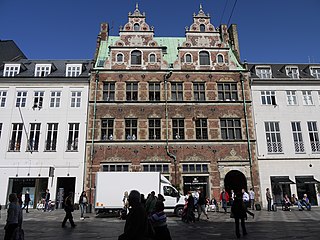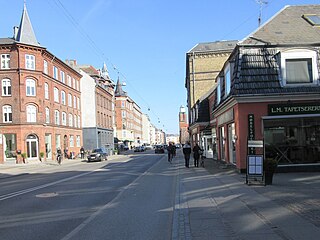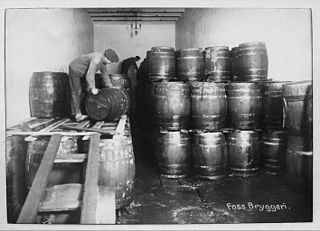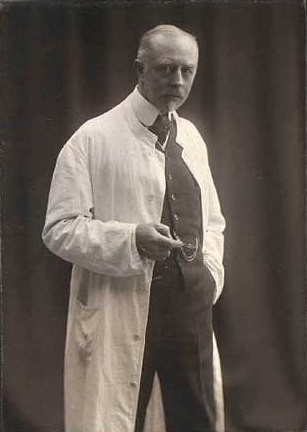
Christian IX was King of Denmark from 15 November 1863 until his death in 1906. From 1863 to 1864, he was concurrently Duke of Schleswig, Holstein and Lauenburg.

Jens Schou Fabricius was the Norwegian appointed Minister of the Navy 1817–1818. He served as a representative for Søe-Deffensionen at the Norwegian Constitutional Assembly at Eidsvoll in 1814. During his naval career he served first the Danish Crown until the separation in 1814 of Norway from Denmark, and thereafter the Norwegian-Swedish Crown. Fabricius retired from the navy as a vice admiral.

The Copenhagen Fire of 1728 was the largest fire in the history of Copenhagen, Denmark. It began on the evening of 20 October 1728 and continued to burn until the morning of the 23rd of October 1728. It destroyed approximately 28% of the city and left 20% of the population homeless. The reconstruction lasted until 1737. No less than 47% of the section of the city, which dates back to the Middle Ages, was completely lost, and along with the Copenhagen Fire of 1795, it is the main reason that few traces of medieval Copenhagen can be found in the modern city.

The Nordic exhibition of Industry, Agriculture, and Art of 1888 was an exhibition that aimed to feature the best of art, industry, and agriculture from the five Nordic countries. It was a joint-venture between 29 organisations and institutions, with the weight on the private side, represented foremost by the Association of Copenhagen Industrialists. The exhibition was located in Copenhagen, Denmark.

Royal Copenhagen, officially the Royal Porcelain Factory, is a Danish manufacturer of porcelain products and was founded in Copenhagen in 1775 under the protection of Danish Dowager Queen Juliane Marie. It is recognized by its factory mark, the three wavy lines above each other, symbolizing Denmark's three water ways: Storebælt, Lillebælt and Øresund.
Royal Copenhagen 2010 plaquettes are a series of small, collectible round flat plaquettes produced by Danish factories, Aluminia and Royal Copenhagen. The numbered and named series of 3-1/4” (80 mm) faience miniplates or "plaquettes" are generally round, though a few are square. The most common colors are moderate to deep blue on a white background, though some have additional colors.
Rasmus Harboe was a Danish sculptor. He was a frequent collaborator with several of the leading Danish architects of his time, including Martin Nyrop.

The Lindencrone Mansion is a historic building located on the corner of Bredgade and Sankt Annæ Plads in central Copenhagen, Denmark. Completed in 1753, it is one of many town mansions which were built for wealthy citizens in the district Frederiksstaden in the years after its foundation in the middle of the 18th century.

The Matthias Hansen House, formerly also known as the Schoustrup House, is a Renaissance-style townhouse on Amagertorv in central Copenhagen, Denmark. Built in 1616, it is one of few buildings of its kind which has survived the Copenhagen Fires of 1728 and 1795. The building is now home to a flagship store for the Royal Copenhagen porcelain factory.

Porcelænshaven in the Frederiksberg district of Copenhagen, Denmark, is the former premises of the Royal Porcelain Manufactury, an industrial complex dating from the 1880s which was converted into a mixed-use neighbourhood in the 2000s. Located on the corner of Søndre Fasanvej and Smallegade, adjacent to Frederiksberg Gardens, it has an area of about five hectares and consists of a mixture of dwellings, commercial space and premises for Copenhagen Business School, whose main campus is located nearby. Many of the historical buildings have been retained, including a landmark chimney and the listed director's residence from 1908.

Smallegade is a busy shopping street in the central part of Frederiksberg in Copenhagen, Denmark. It runs from the Town Hall Square in the east to Fasanvej in the west, along the north side of Frederiksberg Town Hall and Frederiksberg Park, linking Gammel Kongevej with Peter Bangs Vej. On the other side of the Town Hall is Bredegade, now smaller than Smallegade, which after a while joins Smallegade at Møstings Hus, an 18th-century country house-turned-exhibitions space, which overlooks a small pond.

Valdemar Ingemann was a prolific Danish architect active during the late 19th and early 20th century. His works include the Royal Copenhagen Porcelain Manufactury in Frederiksberg, Copenhagen.

Hansen, Schou & Weller was a photographic studio in Copenhagen. Many celebrities sat for portraits there in the last decades of the 19th century.

Helen Schou was a Danish sculptor most known for her works of horses. Her two most-known commissions are the equestrian statue of King Christian IX commissioned for the Aarhus Cathedral and the Jutland Stallion commissioned by the City of Randers. She was honored as a Knight of the Order of the Dannebrog in 1965 and elevated to a Knight 1st Class in 1974.

The Foss Brewery was a brewery in Oslo. The company was started in 1836 as the Ytteborg Brewery and was located on Hausmanns gate. In the 19th century, the water in the lower part of the Aker River became too contaminated to brew beer, and the brewery needed more space. Therefore in 1897 the brewery relocated to new premises further upriver, above the town's Grünerløkka district at Upper Falls —one of two waterfalls forming Vøyen Falls. The company also changed its name to Foss Bryggeri to reflect the new location.

Arnold Krog was a Danish architect, painter and designer who is remembered for his achievements as artistic director of Royal Copenhagen from 1884 to 1916. He revived the company after a period of decline, moving away from the stiff Empire style of previous decades in favour of a more Impressionist style which combined underglaze painting techniques with inspiration from Japanese imagery and European naturalism. He designed the Polar Bear Fountain for the Peace Palace in The Hague. He has also designed furniture and silverware and took up landscape painting after his retirement from the porcelain factory in 1916.

Augusta Sophie Wilhelmine Lütken née Schou (1855–1910) was a Danish operatic soprano who, despite her lack of formal schooling, became one of her country's most popular singers in the nine short years she performed at Copenhagen's Royal Danish Theatre. As a result of poor health, she was forced to retire in 1885 although she returned to make a few appearances in the 1890s.

The Philip de Lange House, built in association with a nitrary in the 1750s, is the Rococo-style former home of Dutch-Danish architect and master builder Philip de Lange at Prinsessegade 54 in the Christianshavn neighborhood of Copenhagen, Denmark. It was from 1877 to 1864 part of the Royal Porcelain Manufactory's Christianshavn factory and is now hidden from the street by a school building from 1865. The house was listed on the Danish registry of protected buildings and places in 1932. It is now part of Christianshavn School and houses the school's after school programmes.

Frantz Clemens Stephan Weller was a German-born Danish photographer.

Philip Julius Schou was a Danish businessman and industrialist. He was a pioneer of the Danish ceramics industry as the manager of Aluminia and the Royal Copenhagen Porcelain Factory.




















